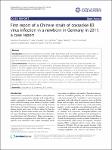First report of a Chinese strain of coxsackie B3 virus infection in a newborn in Germany in 2011: a case report
Ronellenfitsch, Sebastian
Tabatabai, Julia
Böttcher, Sindy
Diedrich, Sabine
Frommhold, David
Schubert-Bast, Susanne
Poeschl, Johannes
Schnitzler, Paul
Introduction: Enteroviruses commonly encounter babies and children and infections present in a wide variety of symptoms ranging from asymptomatic infection, benign illness, and aseptic meningitis, hand-foot-and-mouth disease to severe life-threatening disease. Some newborns develop severe disease in the first 2 weeks of life and long-term sequelae may occur among survivors. Case presentation: We present a case report of a Caucasian newborn baby boy with severe encephalitis and systemic coxsackievirus B3 infection. The coincidence of maternal infection as well as previous mild respiratory illness in his sister suggests either prenatal or horizontal postnatal transmission. An electroencephalogram showed a severe pathologic pattern with theta-delta-rhythm and spike-wave complexes on both hemispheres. We also observed an unusual prolonged viremia for a period of 6 weeks. Due to the lack of specific antiviral treatment options, the supportive management included ventilation and medical treatment of seizures. Phylogenetic analysis revealed a genogroup D2 virus previously exclusively detected in China and now described in Europe for the first time. Conclusions: Enteroviral infection is an important differential diagnosis in neonatal encephalitis. Prolonged viremia must be taken into account and might correlate with disease severity. The newly observed enterovirus genotype D2 is spreading from Asia to other continents.
No license information

